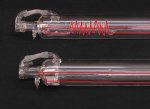Benm
0
- Joined
- Aug 16, 2007
- Messages
- 7,896
- Points
- 113
Pretty cool project!
Just something i'm curious about: Why does this laser require the gas to be refreshed? As I understand most CO2 laser units are sealed, and only require water flow for cooling.
Just something i'm curious about: Why does this laser require the gas to be refreshed? As I understand most CO2 laser units are sealed, and only require water flow for cooling.





